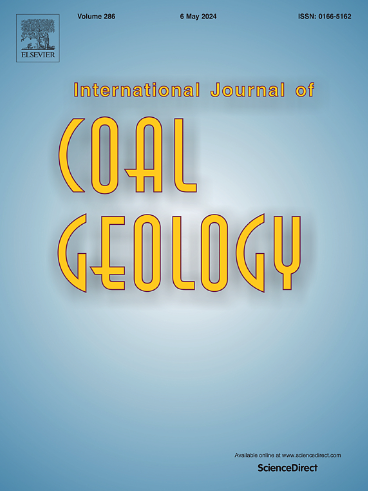煤埋藏变质过程中硫化铁的选择性微量元素吸收:来自斯洛文尼亚东北部含煤Socka床的见解
IF 5.7
2区 工程技术
Q2 ENERGY & FUELS
引用次数: 0
摘要
斯洛文尼亚东北部晚始新世Socka床的含煤基剖面显示与煤有关的硫化铁矿化。详细的岩石学分析确定了黄铁矿和马氏铁矿的五种不同的结构和地球化学变种。地球化学分析显示黄铁矿富集Cu、Zn和Mo,而黄铁矿富集Co、Ni、As、Se和Sb。地球化学指标表明,黄铁矿形成于相对较高的温度、较强的还原条件和较低的pH,这一差异反映在它们的地球化学特征上。黄铁矿中含有与海水入侵有关的微量元素,而黄铁矿中含有与有机质逐步降解和有机结合微量元素释放有关的微量元素。这项研究表明,硫化铁的形成并不局限于单一的沉淀阶段,而是涉及多代矿物,反映了物理化学条件随时间的变化。此外,它表明微量元素的掺入主要受金属的可用性和流体化学的支配,而不是由矿物特异性的选择性封存。这些发现为煤形成环境中硫化物形成的物理化学途径提供了新的见解。本文章由计算机程序翻译,如有差异,请以英文原文为准。

Selective trace element uptake in iron sulfides during burial metamorphism of coal: Insights from the coal-bearing Socka Beds, Northeastern Slovenia
The coal-bearing basal section of the Late Eocene Socka Beds in northeastern Slovenia exhibits iron sulfide mineralization associated with coal. Detailed petrographic analyses have identified five distinct textural and geochemical varieties of pyrite and marcasite. Geochemical analyses reveal that pyrite is notably enriched in Cu, Zn, and Mo, while marcasite shows enrichment in Co, Ni, As, Se, and Sb. Geochemical proxies suggest that marcasite formed under relatively higher temperatures, significantly more reducing conditions, and lower pH compared to pyrite, a distinction that is reflected in their contrasting geochemical signatures. Pyrite incorporates trace elements linked to seawater incursions, while marcasite contains trace elements associated with the progressive degradation of organic matter and the release of organically-bound trace elements. This study demonstrates that iron sulfide speciation is not confined to a single precipitation phase but involves multiple generations of minerals that reflect shifts in physicochemical conditions over time. Additionally, it demonstrates that the incorporation of trace elements is primarily governed by the availability of metals and fluid chemistry, rather than by mineral-specific selective sequestration. These findings offer new insights into the physicochemical pathways that govern sulfide formation in coal-forming environments.
求助全文
通过发布文献求助,成功后即可免费获取论文全文。
去求助
来源期刊

International Journal of Coal Geology
工程技术-地球科学综合
CiteScore
11.00
自引率
14.30%
发文量
145
审稿时长
38 days
期刊介绍:
The International Journal of Coal Geology deals with fundamental and applied aspects of the geology and petrology of coal, oil/gas source rocks and shale gas resources. The journal aims to advance the exploration, exploitation and utilization of these resources, and to stimulate environmental awareness as well as advancement of engineering for effective resource management.
 求助内容:
求助内容: 应助结果提醒方式:
应助结果提醒方式:


